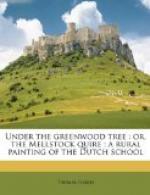Old James (grandfather on the maternal side) had simply called as a visitor. He lived in a cottage by himself, and many people considered him a miser; some, rather slovenly in his habits. He now came forward from behind grandfather William, and his stooping figure formed a well-illuminated picture as he passed towards the fire-place. Being by trade a mason, he wore a long linen apron reaching almost to his toes, corduroy breeches and gaiters, which, together with his boots, graduated in tints of whitish-brown by constant friction against lime and stone. He also wore a very stiff fustian coat, having folds at the elbows and shoulders as unvarying in their arrangement as those in a pair of bellows: the ridges and the projecting parts of the coat collectively exhibiting a shade different from that of the hollows, which were lined with small ditch-like accumulations of stone and mortar-dust. The extremely large side-pockets, sheltered beneath wide flaps, bulged out convexly whether empty or full; and as he was often engaged to work at buildings far away—his breakfasts and dinners being eaten in a strange chimney-corner, by a garden wall, on a heap of stones, or walking along the road—he carried in these pockets a small tin canister of butter, a small canister of sugar, a small canister of tea, a paper of salt, and a paper of pepper; the bread, cheese, and meat, forming the substance of his meals, hanging up behind him in his basket among the hammers and chisels. If a passer-by looked hard at him when he was drawing forth any of these, “My buttery,” he said, with a pinched smile.
“Better try over number seventy-eight before we start, I suppose?” said William, pointing to a heap of old Christmas-carol books on a side table.
“Wi’ all my heart,” said the choir generally.
“Number seventy-eight was always a teaser—always. I can mind him ever since I was growing up a hard boy-chap.”
“But he’s a good tune, and worth a mint o’ practice,” said Michael.
“He is; though I’ve been mad enough wi’ that tune at times to seize en and tear en all to linnit. Ay, he’s a splendid carrel—there’s no denying that.”
“The first line is well enough,” said Mr. Spinks; “but when you come to ‘O, thou man,’ you make a mess o’t.”
“We’ll have another go into en, and see what we can make of the martel. Half-an-hour’s hammering at en will conquer the toughness of en; I’ll warn it.”
“’Od rabbit it all!” said Mr. Penny, interrupting with a flash of his spectacles, and at the same time clawing at something in the depths of a large side-pocket. “If so be I hadn’t been as scatter-brained and thirtingill as a chiel, I should have called at the schoolhouse wi’ a boot as I cam up along. Whatever is coming to me I really can’t estimate at all!”
“The brain has its weaknesses,” murmured Mr. Spinks, waving his head ominously. Mr. Spinks was considered to be a scholar, having once kept a night-school, and always spoke up to that level.




